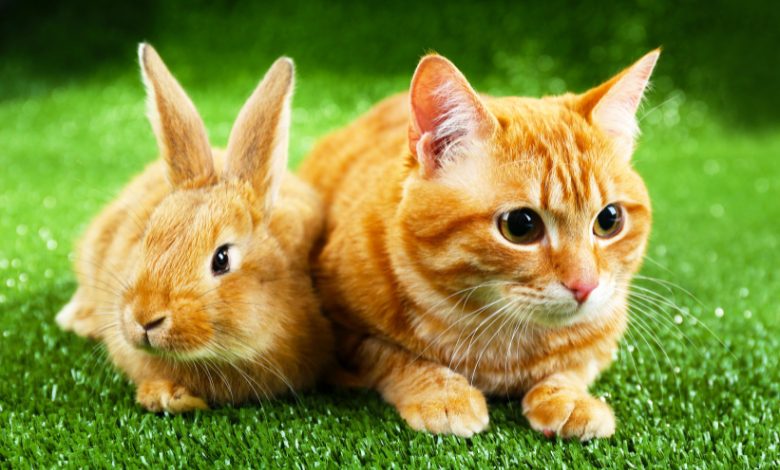Curious if cats and bunnies can be friends? Discover expert tips on fostering harmony and building trust between these unlikely companions.
Cats and bunnies, two creatures that couldn’t seem more different. One is a predator with sharp instincts, while the other is a prey animal by nature. But does that mean they can’t coexist peacefully? Absolutely not. In fact, with the right approach, these two can live not only in harmony but may even become friends. Let’s dive into what you need to know to make it work.
Article Breakdown
Understanding Their Natural Instincts
The Predator and Prey Dynamic
Cats, no matter how domesticated, retain their ancestral hunting instincts. Rabbits, on the other hand, are hardwired to flee from perceived threats. This predator-prey dynamic is the biggest hurdle when introducing the two animals. Recognizing this natural behavior is key to managing their interactions.
But before you write off the idea entirely, know this: many cats are not hunters, and many rabbits are more fearless than you’d expect.
Temperament Matters
Not all cats are aggressive hunters, and not all rabbits are timid. Some cat breeds, like Ragdolls and Persians, are famously docile, while certain rabbit breeds, such as the Flemish Giant, are more confident and laid-back. Matching temperaments can be a game-changer.
Preparing for the Introduction
Assess Your Pets’ Personalities
Take a close look at your cat’s and rabbit’s personalities. Does your cat tend to chase anything that moves? Is your bunny particularly skittish? Answering these questions will help you gauge the potential challenges.
Secure the Environment
Before introducing the two, set up a safe space for your bunny. This could be a roomy enclosure or a separate room where they feel secure. Cats should never have unsupervised access to the rabbit’s space, at least not initially.
Start with Scent
Cats and rabbits rely heavily on their sense of smell. Before any face-to-face meeting, allow them to get used to each other’s scents. Swap bedding or gently rub a cloth on one animal and leave it near the other. This helps them associate the smell with safety, not threat.
The Introduction Process
Visual Introductions
Begin with a visual introduction, keeping the rabbit in its secure enclosure. Let the cat observe from a distance. This step helps both animals grow accustomed to each other without direct interaction.
Gradual Face-to-Face Meetings
When both seem comfortable, move to a controlled meeting. Keep the cat on a leash or in your arms and allow the rabbit to move freely. Watch their body language closely. Signs of aggression, like hissing or lunging, mean it’s time to take a step back.
Positive Reinforcement
Reward both animals for calm behavior. Treats and gentle praise create positive associations with each other’s presence. Patience is critical here; building trust takes time.
Building Long-Term Harmony
Establishing Boundaries
Even if the introduction goes smoothly, it’s crucial to set boundaries. Cats are naturally curious, and rabbits can be territorial. Create separate zones where each animal can retreat when needed.
Supervised Interactions
Never assume they’re ready to be left alone together right away. Continue supervised interactions until you’re confident they’ve established mutual trust.
Individual Attention
Both cats and rabbits need individual care and attention. Ensure each pet feels valued and secure to prevent jealousy or resentment.
Signs They’re Getting Along
So, how do you know if the relationship is on the right track? Look for these positive signs:
- The cat doesn’t show hunting behavior, like stalking or pouncing.
- The rabbit approaches the cat without fear.
- They share the same space calmly, perhaps even lying down near each other.
- Mutual grooming (a rare but golden sign of trust).
What to Do If It’s Not Working
Not all cats and rabbits will become friends, and that’s okay. If you notice persistent signs of fear or aggression, prioritize their safety. Consult a veterinarian or animal behaviorist for advice. Sometimes, coexistence is the best you can aim for, and that’s still a win.
Common Myths About Cats and Rabbits
Myth 1: Cats Will Always Attack Rabbits
While cats are predators, their behavior depends on their personality and environment. Many cats are perfectly capable of coexisting peacefully with rabbits.
Myth 2: Rabbits Are Too Fragile
While it’s true that rabbits require careful handling, they’re not as delicate as they’re often portrayed. With proper precautions, they can hold their own in a multi-pet household.
Myth 3: They’ll Bond Instantly
Bonding takes time and effort. It’s unrealistic to expect instant harmony. Give them the time they need to adjust.
Key Takings
- Understanding the predator-prey dynamic is crucial to ensuring safety.
- Personality and temperament play a significant role in their compatibility.
- Gradual introductions and positive reinforcement are key to fostering trust.
- Always supervise interactions until you’re sure they’ve established mutual respect.
- Even if they don’t become best friends, peaceful coexistence is a realistic goal.



